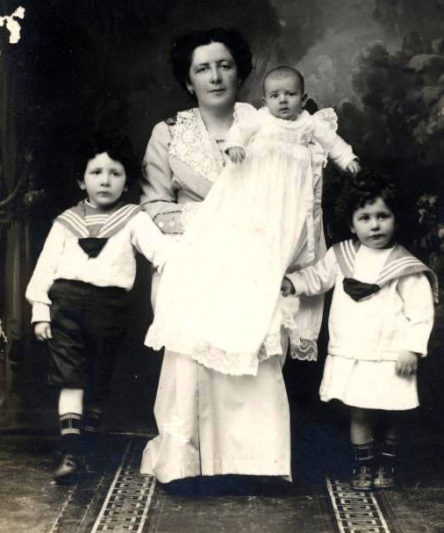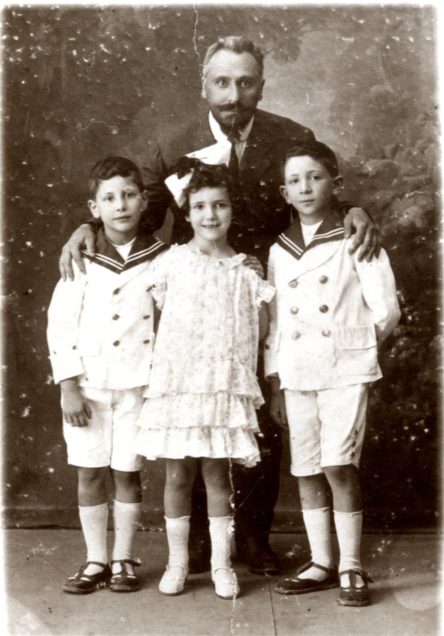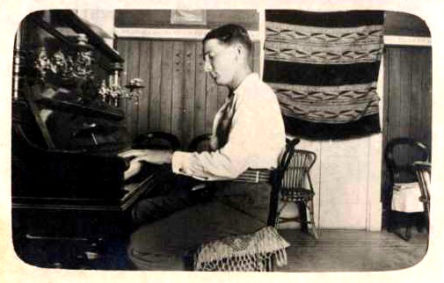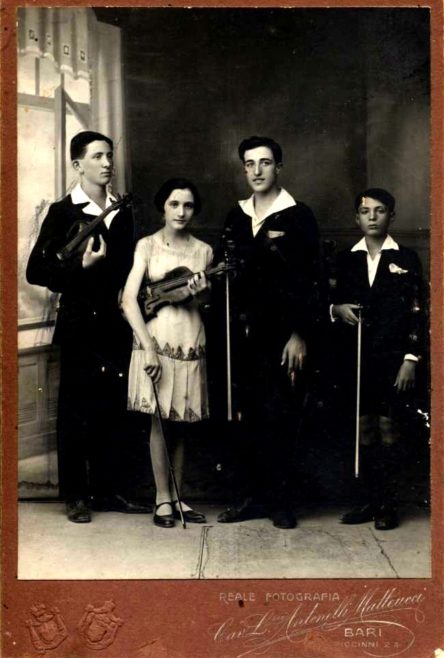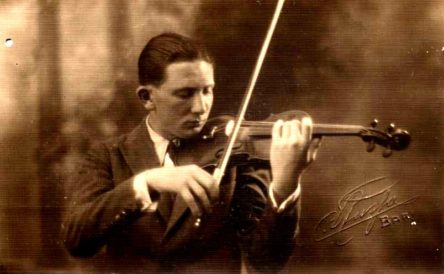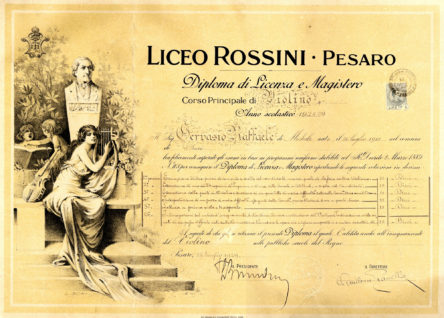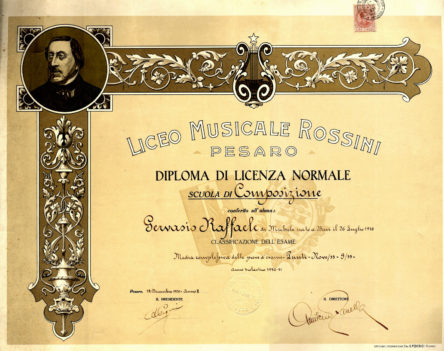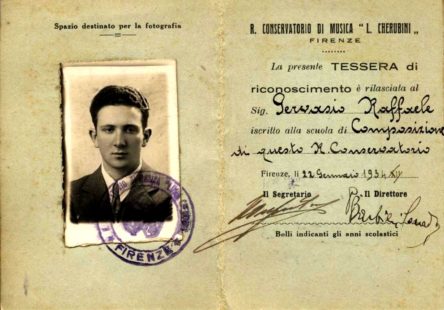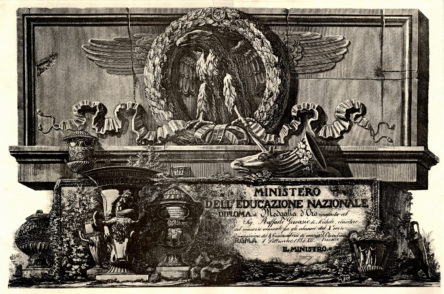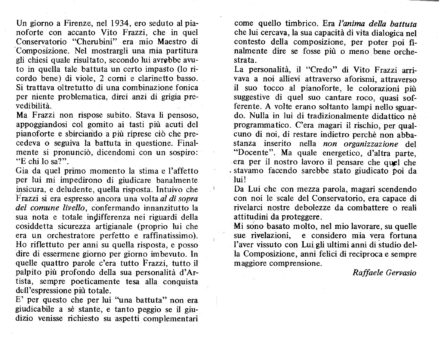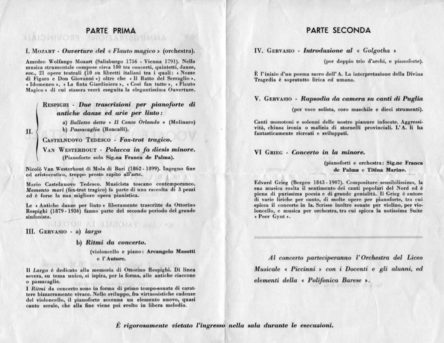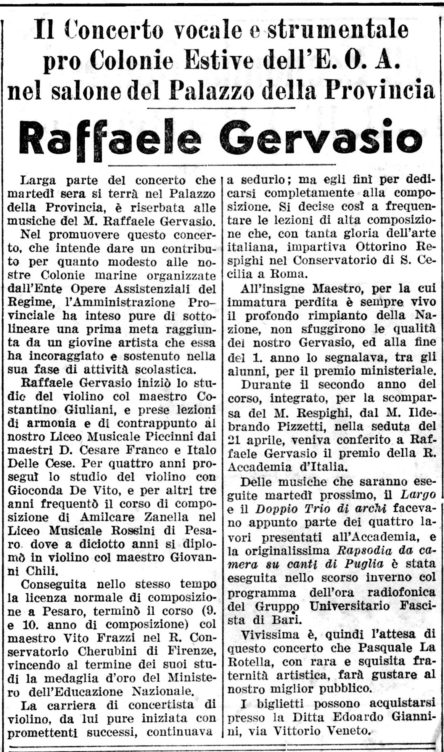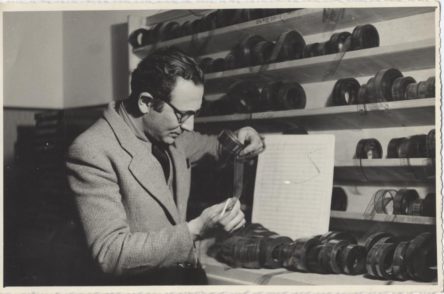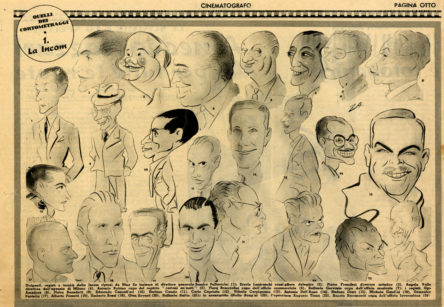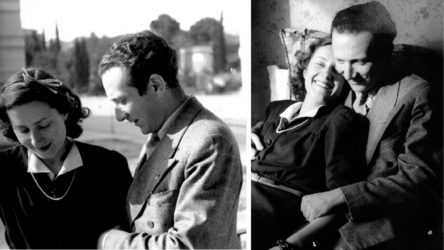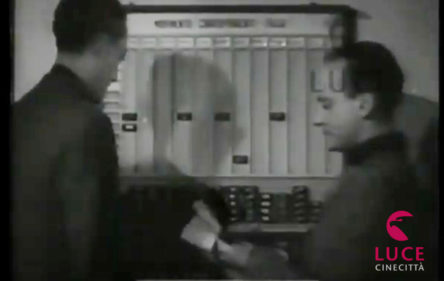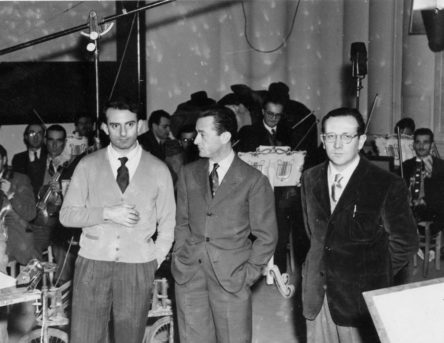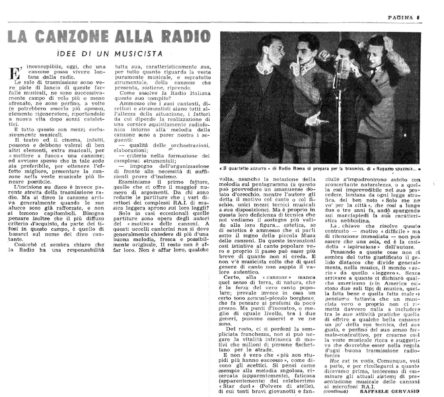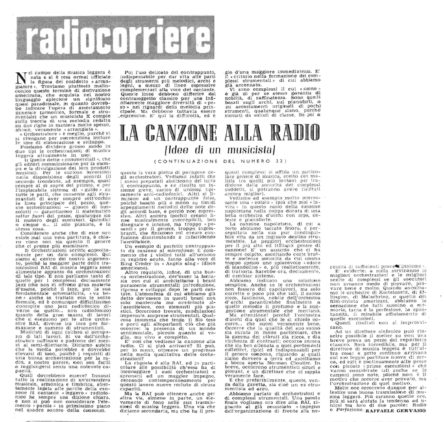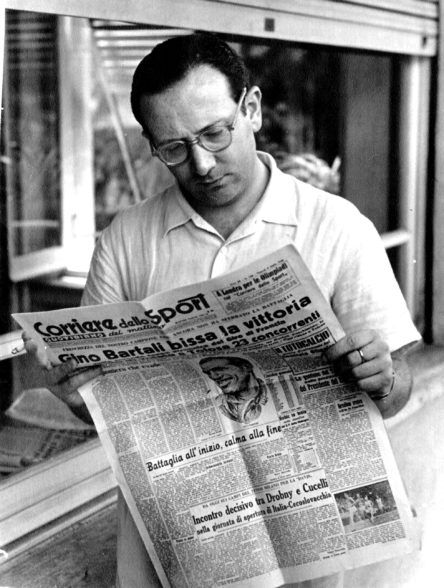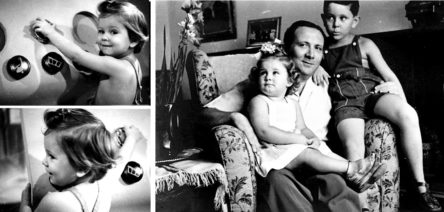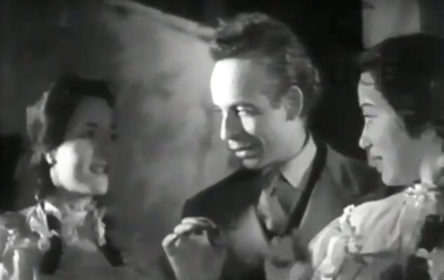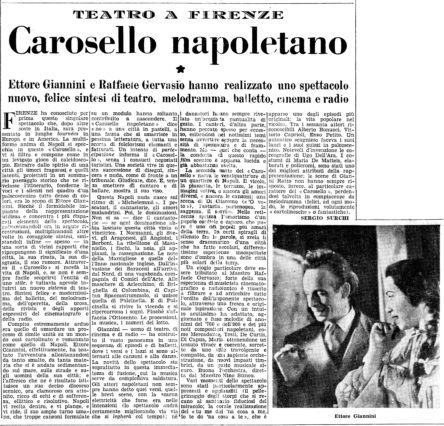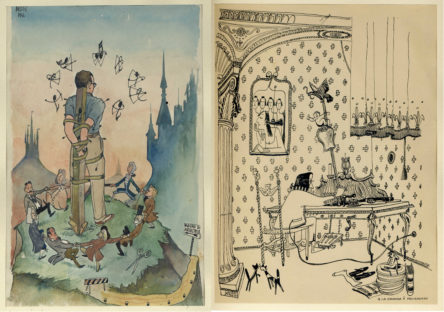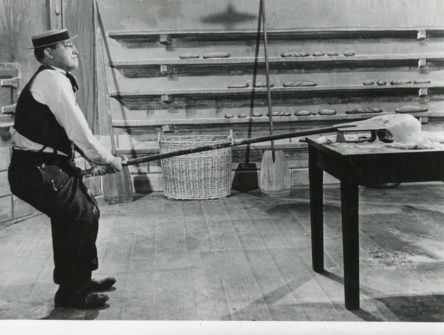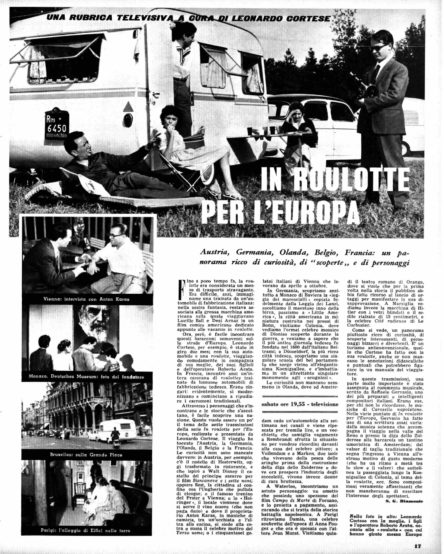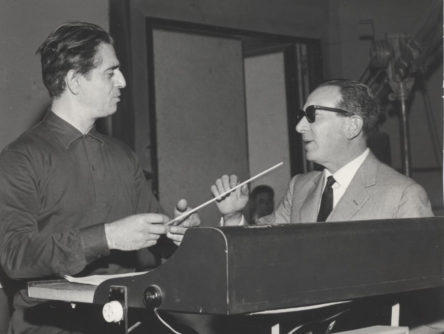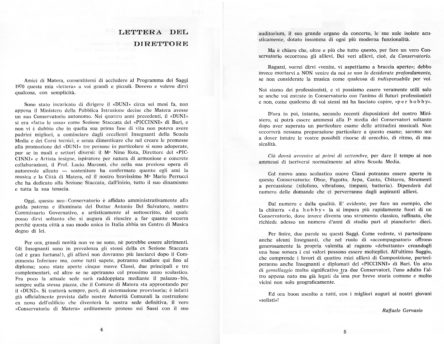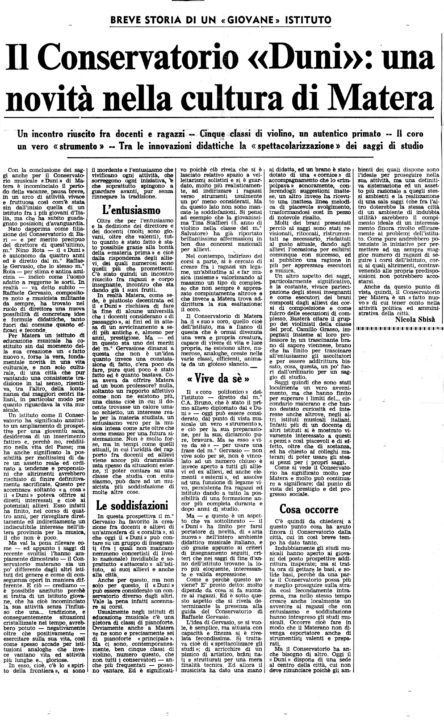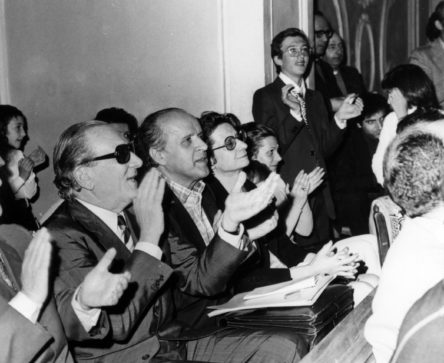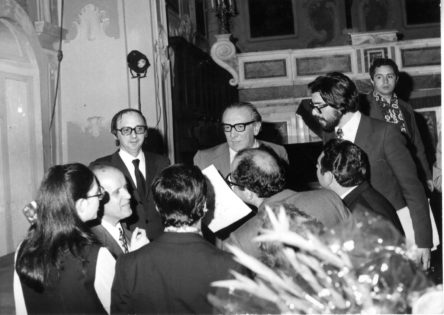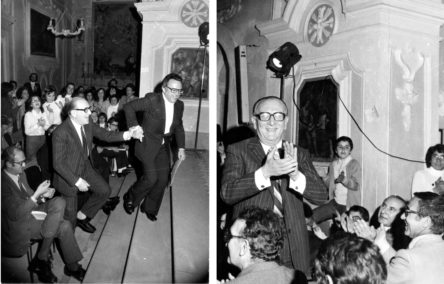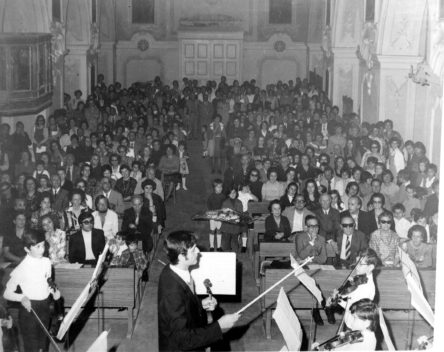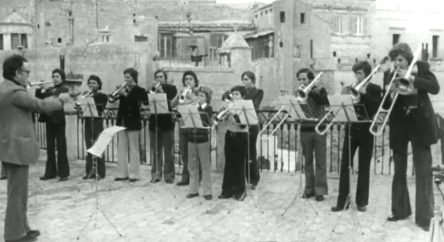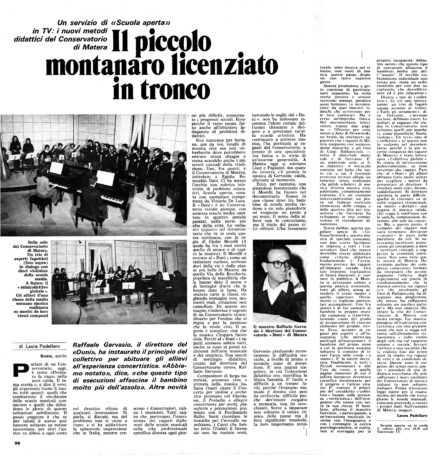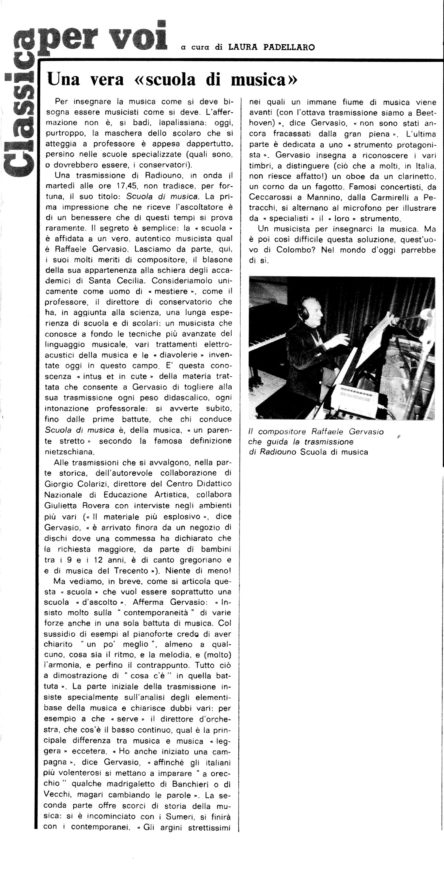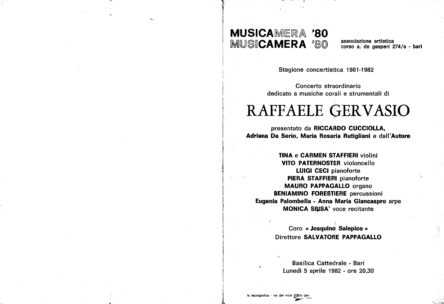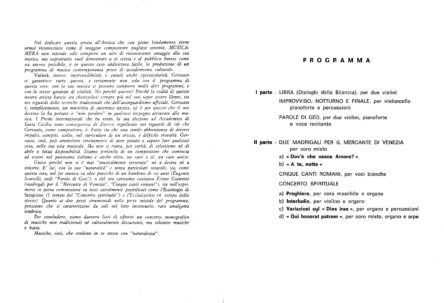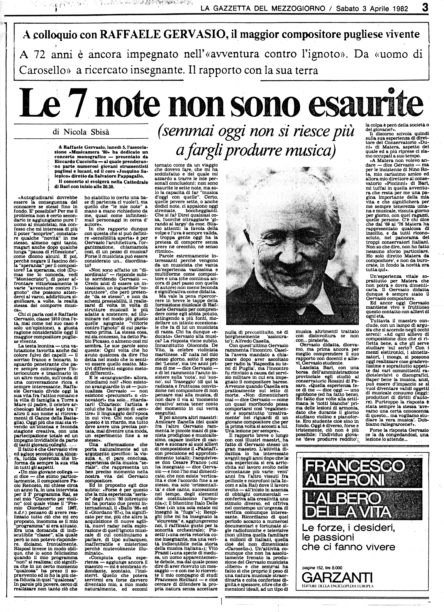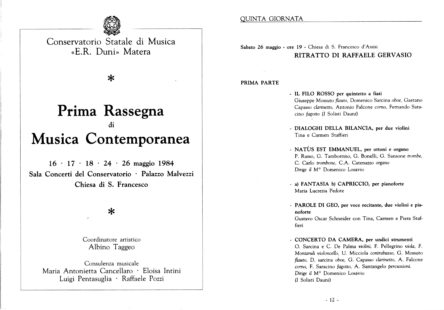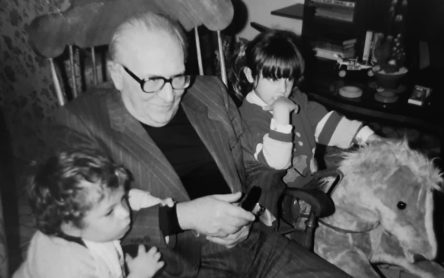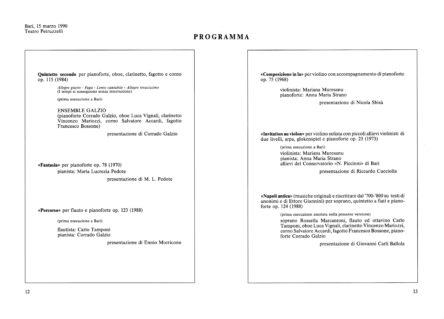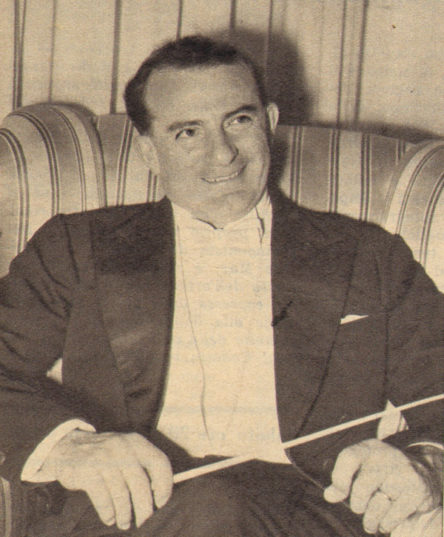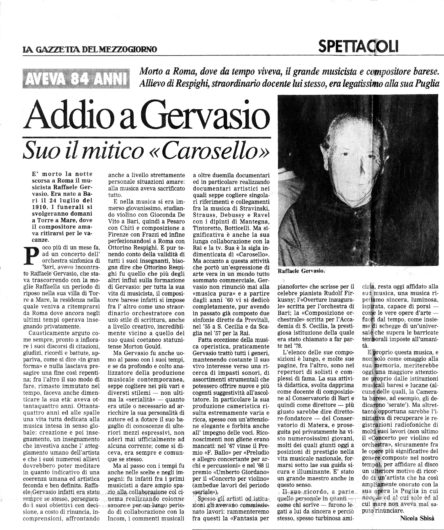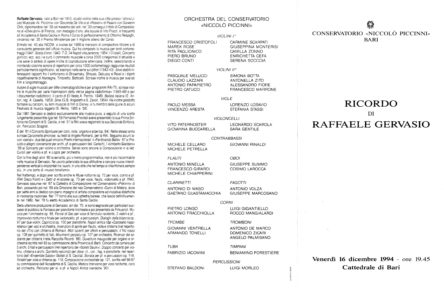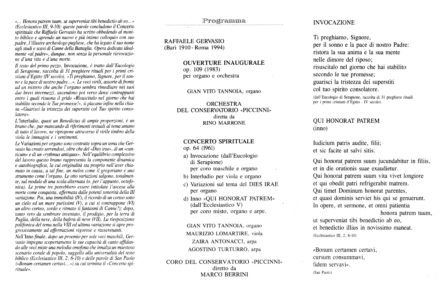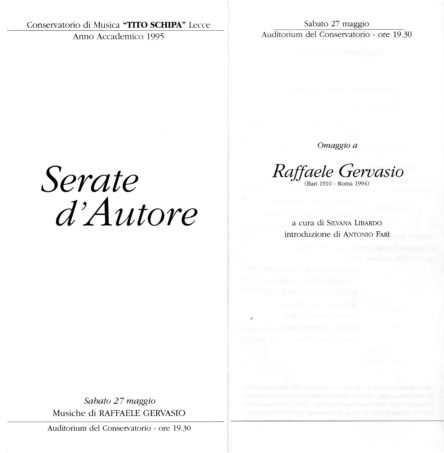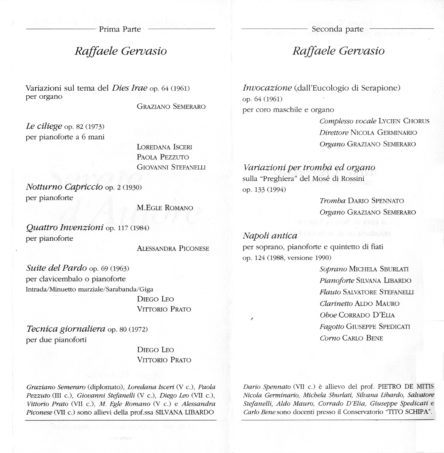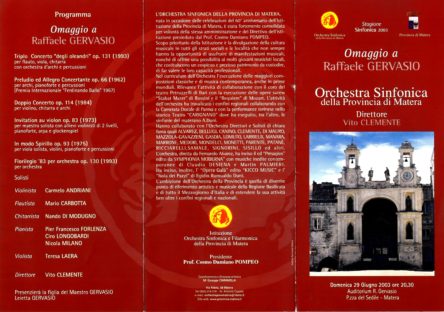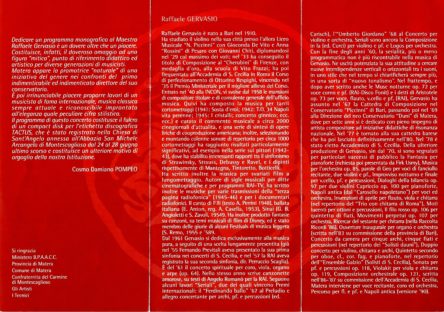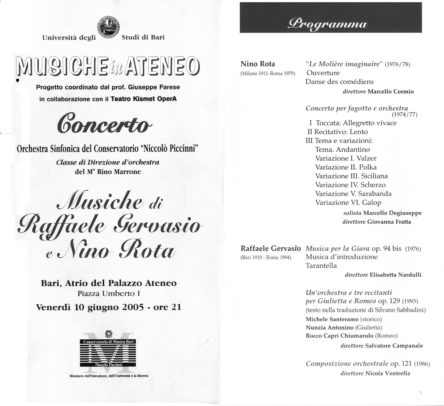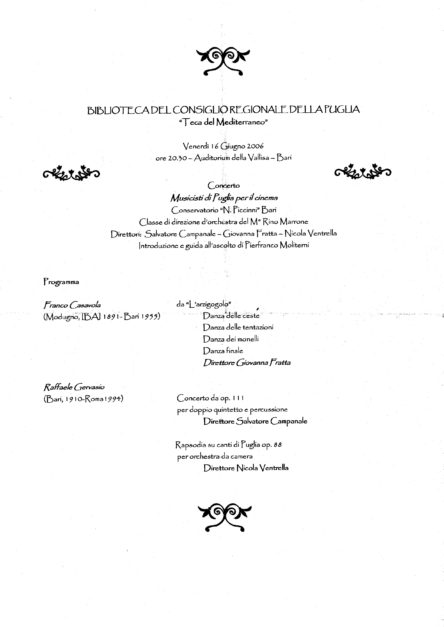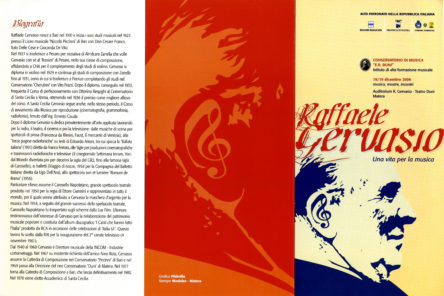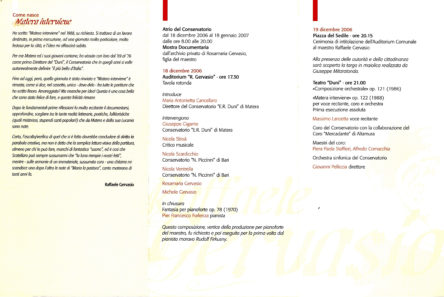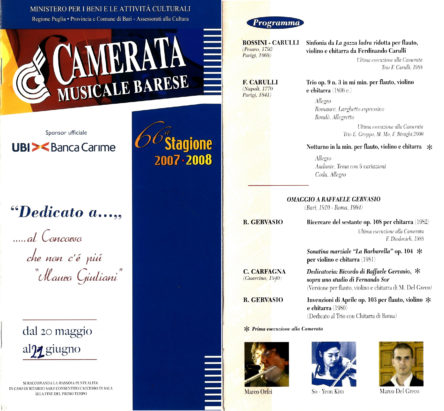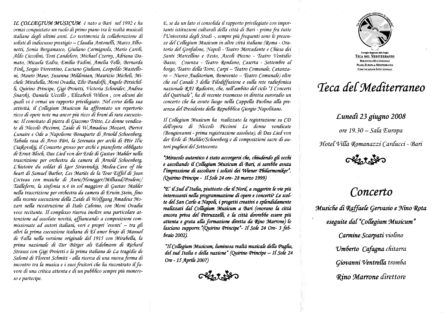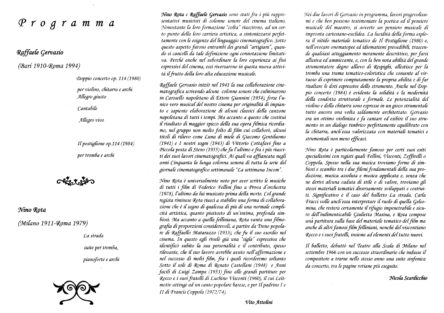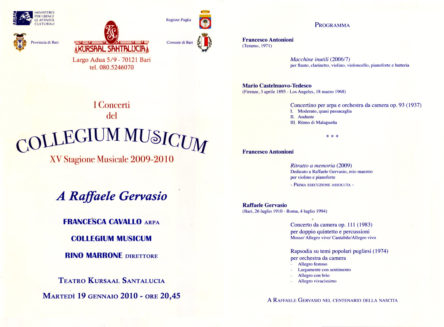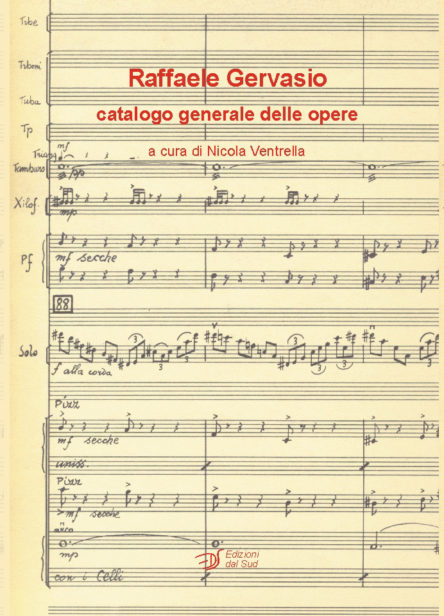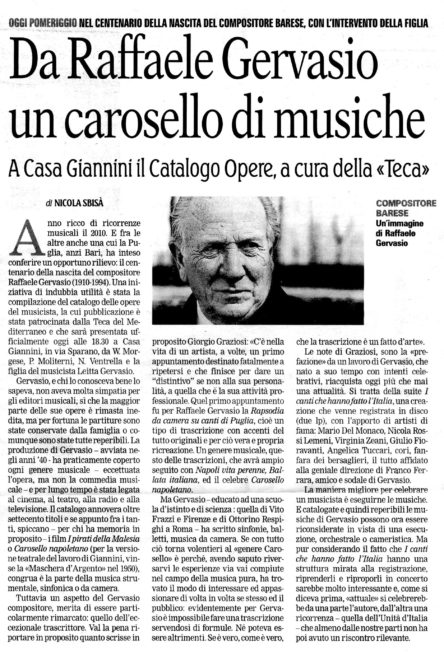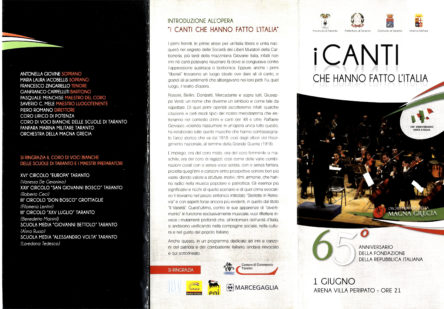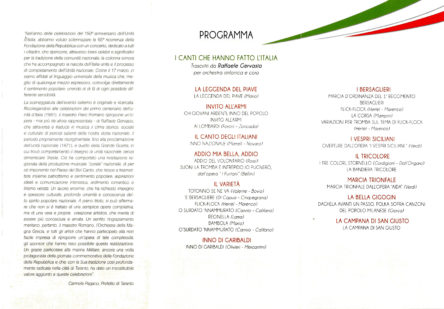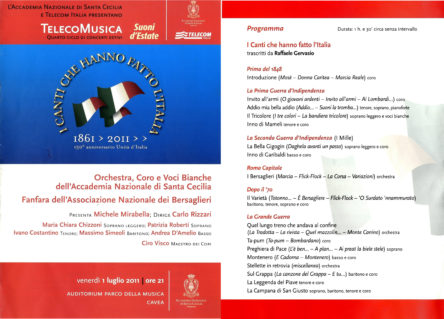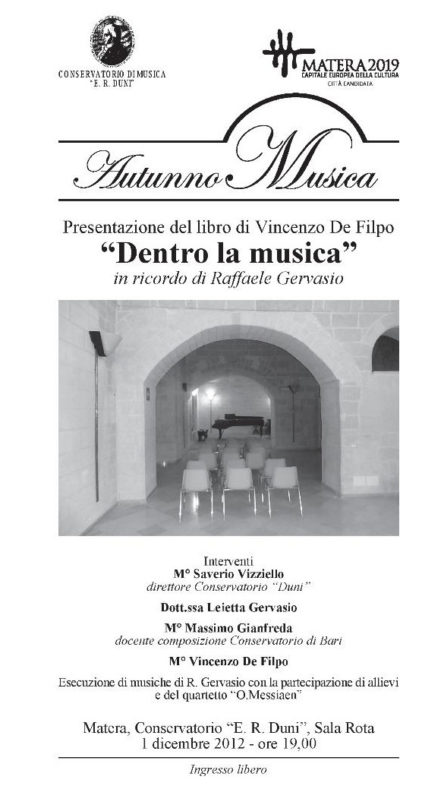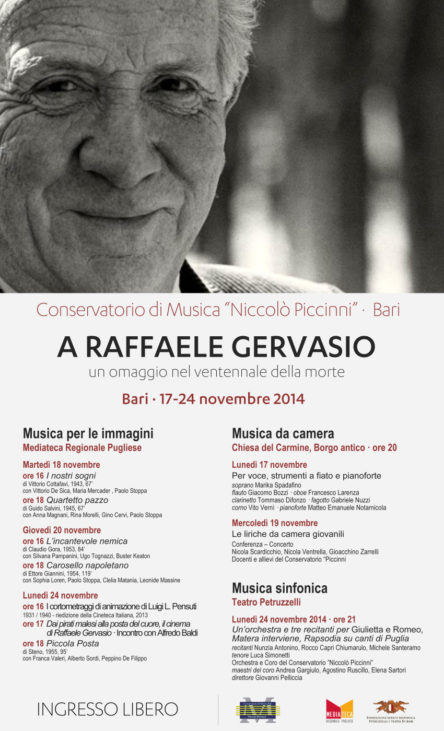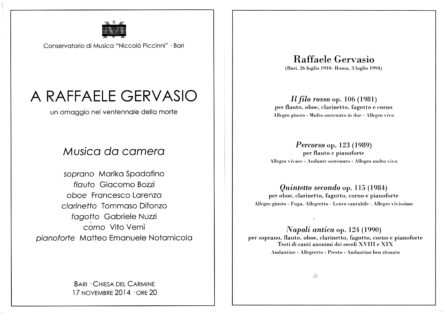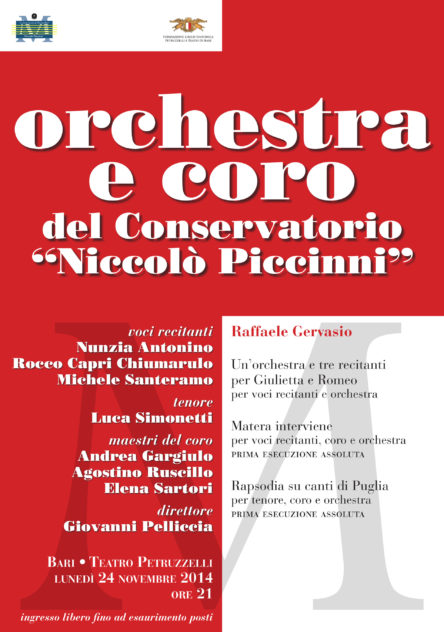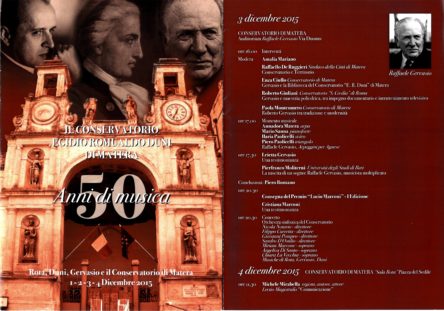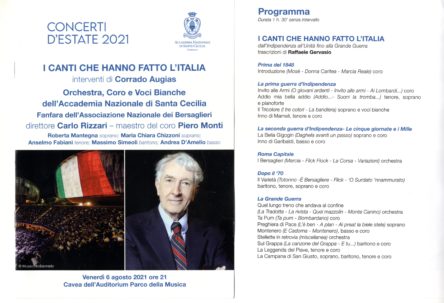Biography
Raffaele Gervasio (Bari 1910 - Rome 1994) was a composer of the twentieth century active in multiple fields of pure and applied music.
After studying Violin and Composition, in the cities of Bari, Pesaro, Florence and Rome, Gervasio settled in the capital in 1940. Whilst here he began to collaborate, firstly as composer and general consultant, then as a music director with INCOM - Industries Short Films of Milan, for whom he wrote original and repertoire music for hundreds of documentaries and newsreels. At the same time he wrote music for theatrical performances and feature films, including the show Carosello Napoletano (that later became a movie), cultural radio segments, repertoire music and tunes for RAI - Radiotelevisione Italiana SpA. In 1961, for the centenary celebrations of the Unification of Italy, he composed an album with two LPs entitled I Canti che hanno fatto l’Italia, with original music, transcriptions and reworkings directed by Franco Ferrara, including a piece of work chosen by RAI for the inauguration of the broadcasts of their second television channel.
In the second half of the 1950s, he resumed his commitment to symphonic music with two Symphonies and in 1960 he ultimately left INCOM to devote himself to music, gradually reducing his other commitments in the field of applied music.
The Sixties were a productive music period with important creative works, including Concerto spirituale (1961) for choir, viola, organ and harps, in memory of his father and the triptych whose protagonist is violin, constituted byPreludio e Allegro Concertante (1962) for strings, piano and percussion, Concerto per violino e orchestra (1966) and the subsequent Composizione in la (1974) for violin and piano. At the end of this period are Logos(1969) for orchestra and Fantasia(1970) for piano, written at the request of Rudolf Firkušný.
In 1967, at the request of Nino Rota, he accepted the Chair of Composition at the Piccinni Conservatory of Bari. Two years later, he took over the direction of the new Duni Conservatory of Matera, which was a detached section of the Bari Conservatory, that in just a few years became independent, fully operational, and also a point of reference in Italy for its teaching. A series of original works and re-elaborations specifically written for the young students of the Conservatory of Matera are from this period.
In 1978 he was elected Academician of Santa Cecilia.
Conclusa l’attività di direzione e di insegnamento si dedica esclusivamente alla composizione. Numerose sono le opere, sia di musica da camera che orchestrale, composte in questo periodo: Invenzioni di aprile (1980), per flauto viola e chitarra, Il filo rosso (1981), per quintetto di fiati, Movimenti perpetui (1982) per orchestra, eseguito a Santa Cecilia, Ouverture inaugurale (1983) per organo e orchestra, commissionato dalla Provincia di Bari, il Doppio concerto (1984), per violino, chitarra e archi, il Quintetto secondo (1984) per fiati e pianoforte, nel repertorio dell’Ensemble Galzio, la Composizione orchestrale (1986) commissionata dall’Accademia di Santa Cecilia, Matera interviene (1988) per voce recitante, coro e orchestra, Un’orchestra e tre recitanti per Giulietta e Romeo (1993), Triplo concerto “degli oleandri“(1993) per flauto, chitarra, viola, più archi e percussioni, Capitoli (1994) per clarinetto in sib, pianoforte e violoncello e le Variazioni sulla preghiera del Mosè di Rossini (1994), per tromba e organo.
Timeline
1910
Raffaele Gervasio was born on the 26th July in Bari, to Michele, archaeologist, and Rosa De Leonardis. Due to the premature death of the eldest daughter Teresa, he was the first of three children (Giuseppe and Elena). He was a precocious child and musically gifted so his parents decided to have him home schooled.
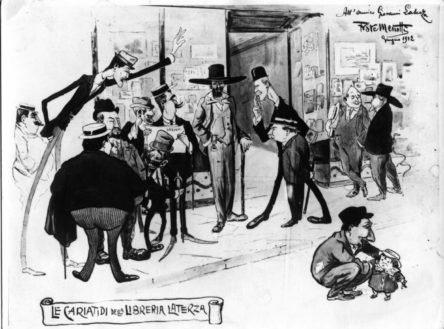
The Caryatids of the Laterza Bookshop
Caricature of Frate Menotti showing the intellectuals who, in 1912, used to haunt the Laterza bookshop in Bari, among them Benedetto Croce with straw hat and walking stick. In the foreground, on the right, Michele Gervasio wearing archeologist overalls with little Raffaele.
1925
Gervasio began attending the Piccinni Musical High School founded by Giovanni Capaldi, which then became the Bari Conservatory. He studied violin with Gioconda De Vito, harmony with Don Cesare Franco and piano with Italo delle Cese. During this time the family relocated from Bari to Torre a Mare.
1927
Almilcare Zanella, honorary director of the Musical High School of Bari, convinced the family to let the young Gervasio attend the 'Gioacchino Rossini' conservatory in Pesaro and attend his composition class. Gervasio studied counterpoint and harmony with Antonio Cicognani and Alessandro Peroni and completed his violin studies with Giovanni Chiti, with whom he graduated with honours in 1929. He remained in Pesaro in 1930 as an apprentice and first violin of the conservatory orchestra and continued to study composition with Zanella.
Gervasio wrote the Notturno-Capriccio op.2, which Zanella published in the magazine Antologia Musicale.
1931
Gervasio completed Op. 2 with a Scherzetto and a Nenia with verses by Michele Campanelli. La Nenia shows his advancement in composition.
In the autumn he moved to Florence where he wrote a piece on a theme by Frazzi.
for the Cherubini Conservatory entrance exam.
1934
Gervasio graduated with Vito Frazzi in 1934, winning the gold medal of the Ministry of National Education withAndante on a theme by Bagnoli.
He moved to Rome where he attended the specialisation course with Ottorino Respighi at the Conservatory of Santa Cecilia and in 1935 he obtained the prize for best student. After Respighi's death in the spring of 1936, he returned for his second year of improvement with Ildebrando Pizzetti.
1936
Gervasio attended the introductory composition course to music for reproduction (cinematography, radio, phonography) held by Eng. Ernesto Cauda at the Conservatory of Santa Cecilia.
He wrote the Rapsodia da Camera su canti di Puglia op.13, that he considered his first "authentic work" whic was performed in Bari on 7h July of the same year, together with the Introduzione al Golgotha op.15, for which he received great appreciation.
1937
Gervasio fulfilled his military service.
Gervasio composed Canti pugliesi per una danza lenta.
1938
After military service Gervasio returned to Rome. He wrote the music for the animated film Crociato 900, by Liberio Pensuti, for an anti-tuberculosis campaign.
1940
Gervasio wrote the music of the documentary Colpi d’Ariete for the anti-tuberculosis campaign, with cartoons by Liberio Pensuti and Ugo Giacomozzi as conductor.
In 1940 he began his relationship, which lasted 20 years, with INCOM - Industrie Cortometraggi Milano, as composer and general consultant first, and then musical director. During this time he added sound to hundreds of documentaries and newsreels, with his original or repertoire music. A very large part of the INCOM repertoire has been archived and made available by the Luce Archive.
1941
Gervasio composed the music for the films Luna di Miele directed by Giacomo Gentilomo, with Assia Noris, and I Pirati della Malesia directed by Enrico Guazzoni with Massimo Girotti and Clara Calamai.
For INCOM he wrote the music for several documentaries, including Armonie giovanili, directed by Stefano Canzio with Ugo Giacomozzi as conductor, Dono dei boschi, directed by Antonio Dell'Anno, Noi Mondine, directed by Vittorio Carpignano with Ugo Giacomozzi as conductor, Sosta d’eroi, directed by Pietro Francisci with Fernando Previtali as conductor, T.O. 34, directed by Vittorio Carpignano with Fernando Previtali as conductor.
Gervasio wrote Preghiera for reciting voice and orchestra on lyrics by Raffaella Botta.
1942
He composed the music of Nel paese dei Ranocchi, the first Italian animated short film in colour by Antonio Rubino, with the EIAR symphony orchestra conducted by Fernando Previtali. It won the gold medal at the Venice International Film Festival in 1942.
He composed the music of INCOM documentaries including Via Margutta directed by Raffaele Saitto, Giuseppe Morelli as orchestra conductor and ensured the coordination and integration of the music for Allegretto a quattro voci, directed by Edmondo Cancellieri, with Fernando Previtali as conductor.
1943
Gervasio married Raffaella Botta in March. He lost his brother Giuseppe, a second lieutenant doctor who went missing in the September bombing of the Bologna train station.
Gervasio composed the music of the film I nostri sogni, directed by Vittorio Cottafavi, with Vittorio De Sica, Paolo Stoppa and Maria Mercader, and INCOM documentaries including Musei Vaticani and Cantico del sole.
1944
Gervasio composed the stage music of two theatrical performances, Faust, a recital directed by Adolfo Celi, and Francesca da Rimini directed by Guido Salvini; and Nuvole for piano.
1945
Gervasio's eldest son Michele was born in January in Torre a Mare, for whom he composed the berceuse A Michele, for piano. He also wrote Pioggia for voice and piano on lyrics by Raffaella Botta.
He composed the music of Quartetto pazzo directed by Guido Salvini, with Gino Cervi, Anna Magnani, Rina Morelli, Paolo Stoppa, and Guglielmo Barnabò.
In 1945 he began to collaborate with RAI - Radio Audizioni Italiane (which in 1954 would become RAI - Radiotelevisione Italiana). His first piece of original radio work was Da Lilì Marlene alla vittoriafor orchestra and speaker on lyrics by Edoardo Anton.
1946
Gervasio wrote the music for the radio pieces Napoli vita perenne and La giornata di una chiesa, both for orchestra and speaker on lyrics by Edoardo Anton.
With the end of the Luce Institute monopoly of information through its newsreels, INCOM organized the Settimana INCOM information newsreel which continued until 1965. In addition to original music and adaptations for thousands of newsreels, he wrote the music for the theme song.
1947
Among other pieces for INCOM, Gervasio composed the music for the short films: L’Italia s’è desta, of which he was co-writer, directed by Domenico Paolella with the orchestra conducted by Fernando Previtali.
One of his articles was published on Radiocorriere in two episodes: Radio Songs. A Musician’s Ideas.
1948
Gervasio composed, among others, the music of INCOM short films: Intermezzo radiofonicodirected by Edmondo Cancellieri, with the Rome Radio Symphony Orchestra of Italy conducted by Fernando Previtali; E il Vesuvio sta a guardaredirected by Domenico Paolella and with the orchestra of the Italian Radio conducted by Franco Ferrara; Thanks America!directed by Domenico Paolella with the orchestra of the Italian Radio conducted by Fernando Previtali.
He composed the music for the radio play Il canto di Elibased on lyrics by Annaluisa Meneghini and Alberto Perrini; while for the theatre he composed the stage music for Il votodirected by Ettore Giannini, with Sarah Ferrati, Salvo Randone and Camillo Pilotto.
1949
Gervasio's daughter Rosa Maria, known by all as Leietta, was born in January in Rome.
Among other pieces for INCOM he composed the music of the short film Marconifor INCOM. It was directed by Pietro Benedetti, with symphony orchestra and choir of Radio Torino conducted by Mario Rossi, .
He composed the soundtrack directed by Fernando Previtali of the film La roccia incantata (1949) directed by Giulio Morelli, with Dina Sassoli and Mirko Ellis.
1950
On April 14th, Carosello napoletano (with the initial title of Neapolitan Carousel) debuts at the Teatro La Pergola in Florence, an Errepì show ([standing for RP] Remigio Paone), directed by Ettore Giannini, with the scenography by Gianni Ratto, choreography by Ugo Dell'Ara, and the costumes by Maria De Matteis. The show was a huge success and went on tour in Europe and America. It won four Maschere d’Argento for subject, direction, scenography and music.
Gervasio composed, among others, the music of INCOM short films: Campionato mondiale di calcio. Gli azzurri in Brasile, directed by Stefano Canzio, with the Italian Radio Symphony Orchestra of Rome conducted by Fernando Previtali, and I cristalli, created by Lando Colombo.
1951
Gervasio composed the music of the films Il capitano nero, directed by Giorgio Ansaldi and Alberto Pozzetti, with the Italian Radio symphonic orchestra of Rome conducted by Fernando Previtali, with Marina Berti and Steve Barclay, Fiamme sulla laguna, directed by Giuseppe Maria Scotese, with Lea Padovani and Leonardo Cortese. For INCOM he composes the music for Fiorenzo il terzo uomopresented in France under the title Le 34° tour d’Italie cycliste, directed by Stefano Canzio.
1953
For RAI Gervasio composed the music for Ballata Italiana, an original piece for radio based on lyrics by Edoardo Anton, directed by Alberto Casella, with the symphonic orchestra and choir of Italian Radio directed by Franco Ferrara, with chorus master Nino Antonellini, and a boys' choir directed by Renata Cortiglioni. The composition was commissioned by RAI and presented at the 5th edition of Premio Italia.
Gervasio composed the music of the film L’incantevole nemica, directed by Claudio Gora, conducted by Franco Ferrara, with Silvana Pampanini, Robert Lamoureux, Carco Campanini, Ugo Tognazzi and a brief role by Buster Keaton.
Among other pieces for INCOM, Gervasio composed the music for the short films: Il miracolo della seta, directed by Lando Colombo, with the Chamber Orchestra of Rome conducted by Franco Ferrara, and Percorso netto, directed by Raimondo Musu, with the Rome Chamber Orchestra conducted by Franco Ferrara.
1954
Among other pieces for INCOM, Gervasio composed the music for the short films: Ballata siciliana, directed by Remigio Del Grosso, conductor Franco Ferrara, Il re dello stagno, directed by Lando Colombo, with music directed by the composer, Sicilia Olimpica, directed by Remigio Del Grosso, with music directed by the composer, and Concerto ginnico, directed by Raimondo Musu, conductor Fernando Previtali.
He composed the music for the radio documentary Sinai, based on lyrics by Gian Battista Angioletti and Sergio Zavoli, wich was presented at the 6th edition of Premio Italia.
The movie Carosello napoletanowas then released in theatres. It was a cinematographic transposition of the theatrical show with the same name, directed by Ettore Giannini, screenplay by Ettore Giannini, Giuseppe Marotta, and Remigio Del Grosso; scenography by Mario Chiari; photography by Piero Portalupi; and the ballets Grand Ballet du Marquis de Cuevas, Le Ballet Africain, French Can-can; choreography by Léonide Massine; and costumes by Maria De Matteis. The film wins the international award at the Cannes festival.
1955
Gervasio completed the first Sinfonia, he had started composing it quite a bit earlier. It was ultimately performed at the Argentina Theatre in Rome by the Symphony Orchestra of the Santa Cecilia Academy conducted by Fernando Previtali. He then composes the Seconda Sinfonia, also called the Sinfonia degli Stadi, performed at the Piccinni Theatre of Bari by the Orchestra of the Piccinni Foundation conducted by Pietro Argento.
He composed the music for the film Piccola posta, directed by Steno, with Franca Valeri and Alberto Sordi.
1956
After repeated attempts at reconciliation, Gervasio and Raffaella Botta agree to split up.
Gervasio composed Allegro da parata, which was then recorded with Franco Ferrara as conductor.
1958
Gervasio wrote original orchestrations and music for a Philips' Son et Lumière [sound and linght] show Romani de Roma, which was supposed to take place at villa Aldobrandini, but was cancelled a few days before its debut.
He composed the music for the ballet Viaggio di nozze, with the choreography of Ugo Dell’Ara, staged at the communal theatre in Bologna in December.
Among other pieces for INCOM he composed the music of the short film Archeologia + petrolio = Sicilia, directed by Giuseppe Scotese.
1959
Gervasio composed the music for the television broadcast Europa in roulotte, nine episodes by Leonardo Cortese and Marco Cesarini Sforza, which tells a story about Europe through a journey made by Cortese with his family in a caravan.
1960
After 20 years Gervasio left INCOM to devote himself almost exclusively to pure music.
In view of the imminent centenary of the unification of Italy, he worked on I canti che hanno fatto l’Italia, a double record album produced by RCA, with original transcriptions, elaborations and music directed by Franco Ferrara, which was released the following year.
1961
For RAI Gervasio composed the Canzonette amorose, for male voice and instruments, on verses by Angelo Romanò.
Gervasio' father Michele died. He composed the Concerto spirituale, for male choir, mixed choir, viola, organ and harps in his father's memory.
The part of I canti che hanno fatto l’Italia relating to the songs of the great war was played in the great inaugural concert of the second RAI channel on 4th November 1961. It was broadcasted live from the Palazzo dello Sport in Rome, with the orchestra and choir of the Italian radio and television, conductor Franco Ferrara, chorus master Nino Antonellini, voices Rosanna Carteri, Raffaele Ariè, Giuseppe Campora and Renato Capecchi, children's choir directed by Renata Cortiglioni, and the fanfare of the National Association Bersaglieri section of Rome.
1962
Gervasio composed the Preludio e allegro concertante, for strings, piano and percussion, which later won the Premio Ballo. He considered it the first part of a triptych that was to have the violin as its protagonist, the following parts of which were to be the Concerto per violino e orchestra and the Composizione in la.
1963
Gervasio composed Un tempo per due, for cello and harp, dedicated to Maria Dongellini Selmi and Giuseppe Selmi, and the Suite del Pardo, for harpsichord or piano.
1966
Gervasio composed the Concerto per violino e orchestra, which was subsequently recorded by RAI with the RAI Symphony Orchestra of Rome conducted by Pierluigi Urbini, with the violinist Pina Carmirelli. It won the Premio Giordano.
Gervasio composed the music performed on stage by the Luca Marenzio madrigalistic ensemble, with the original transcripts and music for Il mercante di Venezia, a theatrical show directed by Ettore Giannini, with Paolo Stoppa, Rina Morelli, Ottavia Piccolo, Tino Carraro.
Gervasio composed the music of Muse Notturne, with lyrics by Enzio Cetrangolo, for soprano, horn and piano.
1967
Gervasio composed the Detti di Aristotele, for soprano, flute, cello, piano and cymbals, the lyrics of which were from I problemi musicali di Aristotele.
Gervasio accepted the Chair of Composition at the Piccinni Conservatory of Bari, upon the invitation by its director Nino Rota, to whom he was bound by friendship and professional esteem.
1968
Gervasio composed the Composizione in la, for violin and piano, written for Bice Antonioni wich became part of her repertoire.
Gervasio's mother Rosa De Leonardis died.
1969
Gervasio composed Logos, for orchestra. Its first performance was with the RAI symphony orchestra conducted by Fernando Previtali.
He agreed to take over the management of the new Duni Conservatory of Matera, formerly a detached section of the Piccinni Conservatory of Bari. This was a particularly challenging task especially in the first phases, that were full of bureaucratic and administrative commitments. Gervasio was engaged with it until 1976, leading the Matera Conservatory to become a reference point in Italy for its active teaching. He later returned to be Chair of Composition until 1980.
1970
Gervasio wrote Fantasia, for piano at the request of the pianist Rudolph Firkusny, who performed it in Bari in 1973.
1971-76
The Essays of the Conservatory become a central point of the didactic activity and Gervasio writes, for the students, numerous original pieces of music, transcriptions and reworkings, some of which will have an independent life in the concert repertoire. For example: Invitation au violon, for solo violin, violins I and II, sistrum and triangle, harp and piano, Apertura, for 5 trumpets in C, horn in F, 3 trombones and organ, Tecnica giornaliera, for two pianos, Le ciliege, for piano with six hands, Arpeggini per Agnese, for harp, organ and percussion, Marcia dei maggiolini, for 3 bassoons, violins, sistrum, triangle, harp and piano, Elaborazione dello studio per clarinetto di Gaetano Donizetti, for Bb clarinet and piano, Cinque canti romani, for chorus of white voices and so on.
1974
Gervasio composed a new instrumentation without voices of the Rapsodia su canti di Puglia for chamber orchestra, which was later directed by Rino Marrone.
1976
Gervasio composed Improvviso notturno e finale, for cello, piano and percussion.
1977
For the violinists Tina and Carmen Staffieri Gervasio composed Dialoghi della Bilancia, for two violins.
1978
Gervasio was elected Academician of Santa Cecilia.
For thirteen episodes starting in October the weekly transmission Scuola di musica, hosted by Gervasio, was broadcast on the national channel Radio Uno.
1979
Gervasio composed Capriccio, for piano and the Concerto per quattro violini and piano that remained unfinished.
1980
Gervasio composed Napoli Antica, for voices, choir and orchestra, which was reworked in chamber version in 1990, Il Postiglione for trumpet and piano composed at the request of Francesco Lentini; and Invenzioni di aprile for viola flute and guitar, dedicated to the violist Giovanni Antonioni and performed with Pietro Romano, flute, and Carlo Carfagna, guitar. He ritired from the didactic activity at the Conservatory.
1981
Gervasio wrote Moti lucenti, for brass and percussion, performed in Bari by the Brass Simphony, conducted by Paolo Lepore; Il filo rosso, for wind quintet, for Domenico Losavio's Dauni Soloists; and, for violin and guitar, the Sonatina marziale La Barbarella.
1982
In April the Musicamera '80 Association in Bari dedicated a monographic concert to Gervasio.
Upon Franco Ferrara's request, Gervasio wrote Movimenti perpetui, for orchestra to be played at the closing concert of the Course for Young Conductors held by Ferrara in Bari. At the request of Carlo Carfagna, Gervasio composed Ricercar del sestante, for guitar.
1983
For the inauguration of the new organ at the Rota Auditorium of the Piccinni Conservatory of Bari, Gervasio composed the Ouverture inaugurale, for organ and orchestra, performed by the Symphony Orchestra of the Province of Bari, conducted by Rino Marrone with the organist Luigi Celeghin. He composed Concerto da camera, for double quintet (five strings and five wind instruments) and percussion, for the Domenico Losavio's Dauni Soloists.
Gervasio composed Introduzione e tema variato, for violin and piano, which he later transcribed for violin and strings.
1984
Gervasio composed various chamber pieces, including Doppio concerto, for violin, guitar and strings, Quintetto secondo, for oboe, clarinet, bassoon, horn and piano, dedicated to the Ensemble Galzio, Indugio compiuto, for voices, violin, guitar, piano and percussion, Quattro invenzioni, for piano and Sonata, for piano and percussion.
In May the Conservatory E.R. Duni of Matera, as part of the First Review of Contemporary Music, organized the concert Portrait of Raffaele Gervasio
In July Gervasio's Elena died and in December his granddaughter Elena, Michele's daughter, was born.
1985
Gervasio composed Violakit, for guitar and viola.
1986
Commissioned by the National Academy of Santa Cecilia Gervasio wrote Composizione orchestrale, , that was performed in 1988 by the Orchestra of the Academy of Santa Cecilia conducted by Yoav Talmi.
In January the grandson Ruggero, Leietta's son, is born.
1988
In view of the first visit of a President of the Republic to Matera, commissioned by the Province, composed the piece Matera interviene, for reciting voice, choir and orchestra. The visit was cancelled and the first performance was later in 2006.
1989
Gervasio composed Percorso, for flute and piano.
1990
On the 15th of March the Camerata Musicale of Bari, conducted by Gianni Antonioni, organized a concert at the Petruzzelli theatre that was entirely dedicated to Gervasio and entitled Raffaele Gervasio “il compositore barese”.
He participated in the commemoration of Fernando Previtali in September, five years after his death.
1991
Gervasio composed Rivelazioni, for reciting voice, baritone, mixed chorus and orchestra for the 1991 Sacred Music Festival in Rome. The concert was cancelled and the song was never performed; Parabola, for clarinet and piano; Nel vivo, for clarinet quartet.
1992
For the Messiaen quartet, at the request of the pianist Vincenzo De Filpo, Gervasio composed Riscrittura, for violin, cello, Bb clarinet, bass clarinet and piano, which as the title suggest, was a reworking of the Preludio e allegro concertante.
1993
Gervasio composed Un’orchestra e tre recitanti per Giulietta e Romeo, for three voices and orchestra; Florilegio ’83, for orchestra a third version of the Concerto da camera; Triplo concerto degli oleandrifor flute, viola, guitar and orchestra.
1994
For the Ensemble Galzio Gervasio composed Capitoli, for clarinet, piano and cello and for Mauro Maur the Variazioni sulla preghiera del Mosè di Rossinifor trumpet and organ.
Raffaele Gervasio died in Rome in July.
In December the Conservatory Niccolò Piccinni of Bari organized the concert In memory of Raffaele Gervasio in the Cathedral of Bari.
1995
The Tito Schipa Conservatory of Lecce dedicated a Homage to Raffaele Gervasio
2003
The Symphony Orchestra of the Province of Matera, conducted by Vito Clemente, organized the concert in Homage to Raffaele Gervasio
2005
The University of Bari organized the concert with Music by Raffaele Gervasio and Nino Rota
2006
Teca del Mediterraneo organized the Musicians of Puglia for the Cinemaconcert, with music by Franco Casavola and Raffaele Gervasio.
The Conservatory E.R. Duni of Matera organized Raffaele Gervasio, a Life Dedicated to Music, two days of music, exhibitions and meetings dedicated to Gervasio, promoted by the Conservatory Auditorium, with the first performance of Matera interviene
2008
The Camerata Musicale of Bari organized a Homage to Gervasio, with music performed by the Trio l'Orage
Teca del Mediterraneo organized the concert with Music by Raffaele Gervasio and Nino Rota, performed by the Collegium Musicum directed by Rino Marrone.
2010
The Collegium Musicum, conducted by Rino Marrone, organized the concert To Raffaele Gervasio
On the centenary of his birth, the General catalogue of Raffaele Gervasio's workswas published, edited by Nicola Ventrella, for Edizioni Dal Sud.
2011
On the occasion of the celebration of the 150th anniversary of the unification of Italy, two concerts were played from the album I canti che hanno fatto l’Italia The first was in Taranto, on the 1st of June, with the Orchestra della Magna Grecia directed by Piero Romano, with the opera choir of Potenza, and the children’s choir from the schools of Taranto, and the Fanfare of the Navy Troops of Taranto. The second concert was in Rome, on the 1st of July, at the Auditorium Parco della Musica with the orchestra, choir, and children’s choir of the Accademia Nazionale di Santa Cecilia, and the Fanfare of the National Association of Bersaglieri Troops, directed by Carlo Rizzari.
2012
In December the book Inside Music. In Memory of Raffaele Gervasio was presented in Matera by Vincenzo De Filpo.
2014
The Conservatory of Music Niccolò Piccinni of Bari organized the initiative To Raffaele Gervasio, a homage on the twentieth anniversary of his death with the creation of a series of events carried out over a week, from the 17th to the 24th November, which included the screening of films and animated short films, the performance of chamber music, lyrics from his youth and the performance of symphonic music.
2015
The Conservatory E.R. Duni of Matera celebrated 50 years of music by dedicating a series of in-depth and musical events to Egidio Romualdo Duni, to whom the Conservatory was dedicated, to Nino Rota, who was the first director of the detached section of the Bari Conservatory and to Raffaele Gervasio, who was the first director of the autonomous Conservatory.
2021
On the occasion of the celebration of the 160th anniversary of the unification of Italy, a concert was played from the album I canti che hanno fatto l’Italia. The concert was in Rome, on the 6th of August, at the Auditorium Parco della Musica with the orchestra, choir, and children’s choir of the Accademia Nazionale di Santa Cecilia, and the Fanfare of the National Association of Bersaglieri Troops, directed by Carlo Rizzari.
